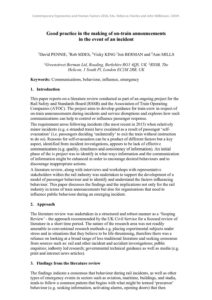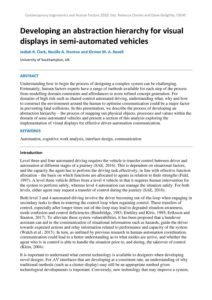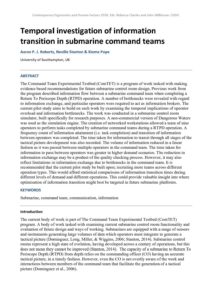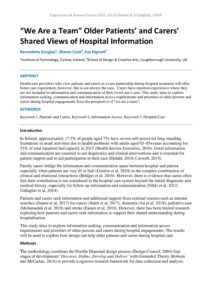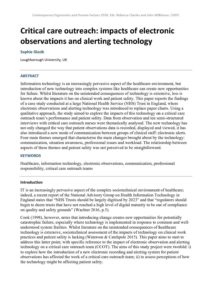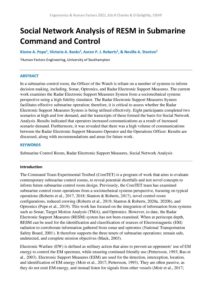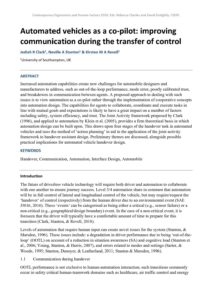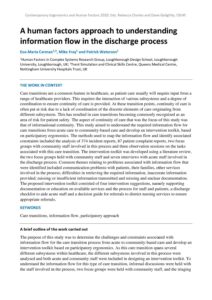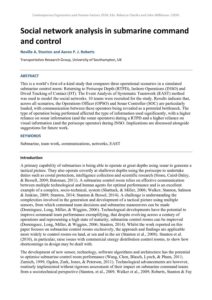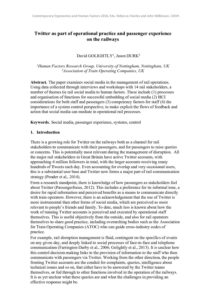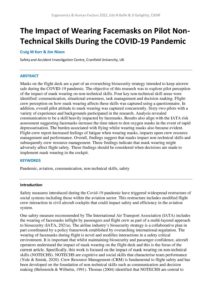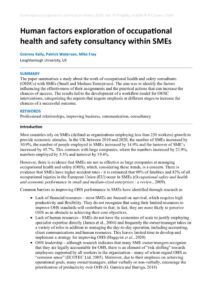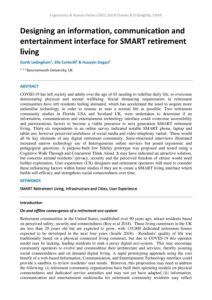Communication
Good practice in the making of on-train announcements in the event of an incident
| Document | Author David PENNIE, Rob SIDES, Vicky KING, Jon BERMAN and Ann MILLS |
| Abstract |
Developing an abstraction hierarchy for visual displays in semi-automated vehicles
| Document | Author Jediah R. Clark, Neville A. Stanton and Kirsten M. A. Revell |
| Abstract Understanding how to begin the process of designing a complex system can be challenging. Fortunately, human factors experts have a range of methods available for each step of the process from modelling domain constraints and affordances to more refined concept generation. For domains of high risk such as shared-control automated driving, understanding what, why and how to construct the environment around the human to optimise communication could be a major factor in preventing fatal collisions. In this presentation, we describe the process of developing an abstraction hierarchy – the process of mapping out physical objects, processes and values within the domain of semi-automated vehicles and present a section of this analysis exploring the implementation of visual displays for effective driver-automation communication. |
Temporal investigation of information transition in submarine command teams
| Document | Author Aaron P. J. Roberts, Neville Stanton & Kiome Pope |
| Abstract The Command Team Experimental Testbed (ComTET) is a program of work tasked with making evidence based recommendations for future submarine control room design. Previous work from the program described information flow between a submarine command team when completing a Return To Periscope Depth (RTPD) operation. A number of bottlenecks were revealed with regard to information exchange, and particular operators were required to act as information brokers. The current pilot study aims to build on such work by examining the temporal implications of operator overload and information bottlenecks. The work was conducted in a submarine control room simulator, built specifically for research purposes. A non-commercial version of Dangerous Waters was used as the simulation engine. The creation of networked workstations allowed a team of nine operators to perform tasks completed by submarine command teams during a RTPD operation. A frequency count of information attainment (i.e. task completion) and transition of information between operators was completed. The time taken for information to transit through all stages of the tactical picture development was also recorded. The volume of information reduced in a linear fashion as it was passed between multiple operators in the command team. The time taken for information to pass between operators was greater in higher demand scenarios. The reduction in information exchange may be a product of the quality checking process. However, it may also reflect limitations in information exchange due to bottlenecks in the command team. It is recommended that the current pilot study be built upon; recruiting more teams across different operation types. This would afford statistical comparisons of information transition times during different levels of demand and different operations. This could provide valuable insight into where optimisation of information transition might best be targeted in future submarine platforms. |
Applying nudge to organisational communications: nudge and source impact on e-learning completion
| Document | Author Ami Chohan, Dr. Ann Bicknell, C.Psychol. |
| Abstract Nudge and its application to decision-making and behavioural change, continues to gain increasing academic and mainstream interest. Mandatory e-learning is now a vehicle which delivers many core and business critical skills including legal compliance with safety and security. In addition, the ‘just in time’ nature of an efficient business requires that employees receive business learning for sales and service offerings as close to the point of use as possible, without limit of geography and supporting learner inclusivity and we have seen a drop in lengthy induction and training courses. It is disappointing then, that the claims made for digital learning procurement are rarely matched by the uptake or measurable transfer from it. There is substantial empirical evidence to support the effectiveness of nudge intervention in the public and domestic domain. However, little attention has focused on its application to the workplace and even less so, in instances where behavioural change is not linked to clear personal reward. This study quantitatively explored whether nudge application and source of communication influenced the probability of employees completing an optional e-learning module. Two hundred and sixty-five employees at a major UK transport organisation were exposed to one of six versions of an email stimulus manipulated by source and nudge application. Third Person Effect, a phenomenon where individuals believe others are more likely to be influenced by mass media communication than themselves, was identified as a potential co-variate. A binomial logistical regression identified ‘nudge, expert source’ and ‘no nudge, authority source’ to be statistically significant predictors for e-learning completion. Findings suggest that information disclosure nudges introduced by an expert source can support organisations in encouraging employees to engage with optional work-based activity where no clear personal reward is identifiable. Non-nudged organisational communications from an authority source are better predictors to encourage compliance driven decision-making and behaviour change. |
“We Are a Team” Older Patients’ and Carers’ Shared Views of Hospital Information
| Document | Author Bernadette Douglas, Sharon Cook and Sue Hignett |
| Abstract Health care providers who view patients and carers as a care partnership during hospital treatment will offer better care experiences, however, this is not always the case. Carers have reported experiences where they are not included in information and communication of their loved one’s care. This study aims to explore information seeking, communication and information access requirements and priorities of older persons and carers during hospital engagements from the perspective of “we are a team”. |
Critical care outreach: impacts of electronic observations and alerting technology
| Document | Author Sophie Glazik |
| Abstract Information technology is an increasingly pervasive aspect of the healthcare environment, but introduction of new technology into complex systems like healthcare can create new opportunities for failure. Whilst literature on the unintended consequences of technology is extensive, less is known about the impacts it has on clinical work and patient safety. This paper reports the findings of a case study conducted at a large National Health Service (NHS) Trust in England, where electronic observations and alerting technology was introduced to replace paper charts. Using a qualitative approach, the study aimed to explore the impacts of this technology on a critical care outreach team’s performance and patient safety. Data from observation and ten semi-structured interviews with critical care outreach nurses were thematically analysed. The new technology has not only changed the way that patient observations data is recorded, displayed and viewed, it has also introduced a new mode of communication between groups of clinical staff: electronic alerts. Four main themes emerged that characterise the main changes brought about by the technology: communication, situation awareness, professional issues and workload. The relationship between aspects of these themes and patient safety was not perceived to be straightforward. |
Social Network Analysis of RESM in Submarine Command and Control
| Document |
|
|
| Abstract In a submarine control room, the Officer of the Watch is reliant on a number of systems to inform decision making, including, Sonar, Optronics, and Radar Electronic Support Measures. The current work examines the Radar Electronic Support Measures System from a sociotechnical systems perspective using a high fidelity simulator. The Radar Electronic Support Measures System facilitates effective submarine operation; therefore, it is critical to assess whether the Radar Electronic Support Measures System is being utilised effectively. Eight participants completed two scenarios at high and low demand, and the transcripts of these formed the basis for Social Network Analysis. Results indicated that operators increased communications as a result of increased scenario demand. Furthermore, it was revealed that there was a high volume of communications between the Radar Electronic Support Measures Operator and the Operations Officer. Results are discussed, along with recommendations and areas for future work. |
Automated vehicles as a co-pilot: improving communication during the transfer of control
| Document | Author Jediah R Clark, Neville A Stanton & Kirsten M A Revell |
| Abstract Increased automation capabilities create new challenges for automobile designers and manufacturers to address, such as out-of-the-loop performance, mode error, poorly calibrated trust, and breakdowns in communication between agents. A proposed approach to dealing with such issues is to view automation as a co-pilot rather through the implementation of cooperative concepts into automation design. The capabilities for agents to collaborate, coordinate and execute tasks in line with mutual goals and expectations is likely to have a great impact on a number of factors including safety, system efficiency, and trust. The Joint Activity framework proposed by Clark (1996), and applied to automation by Klein et al. (2005), provides a firm theoretical basis in which automation design can be built upon. This draws upon four stages of the handover task in automated vehicles and uses the method of ‘action planning’ to aid in the application of the joint activity framework to handover assistant design. Preliminary themes are discussed, alongside possible practical implications for automated vehicle handover design. |
A human factors approach to understanding information flow in the discharge process
| Document | Author Eva-Maria Carman, Mike Fray and Patrick Waterson |
| Abstract Care transitions are a common feature in healthcare, as patient care usually will require input from a range of healthcare providers. This requires the interaction of various subsystems and a degree of coordination to ensure continuity of care is provided. At these transition points, continuity of care is often put at risk due to a lack of coordination of the discrete elements of care originating from different subsystems. This has resulted in care transitions becoming commonly recognised as an area of risk for patient safety. The aspect of continuity of care that was the focus of this study was that of informational continuity. This study aimed to understand the required information flow for care transitions from acute care to community-based care and develop an intervention toolkit, based on participatory ergonomics. The methods used to map the information flow and identify associated constraints included the analysis of 374 incident reports, 87 patient complaint reports, two focus groups with community staff involved in this process and three observation sessions on the tasks associated with this care transition. The intervention toolkit was developed using a literature review, the two focus groups held with community staff and seven interviews with acute staff involved in the discharge process. Common themes relating to problems associated with information flow that were identified included communication problems with patients, their families, other services involved in the process; difficulties in retrieving the required information, inaccurate information provided; missing or insufficient information transmitted and missing and unclear documentation. The proposed intervention toolkit consisted of four intervention suggestions, namely supporting documentation or education on available services and the process for staff and patients, a discharge checklist to aide acute staff and a decision guide for referrals to district nursing services to ensure appropriate referrals. |
Towards Agent-Based Modelling for Situation Awareness: modeling a ships Operations Room
| Document | Author Joanne KITCHIN and Chris BABER |
| Abstract An Agent-Based Model of a Maritime Operations Room is developed. Different versions of the model are run to compare the impact of team structure and information management on performance. The aim of the work is to model Situation Awareness in terms of information flow and team structure. From a description of information flow and operator activity in an Ops Room, we defined key roles, information use and communication for Agents in a model. The model allows us to define rules that reflect different modes of activity. Clear performances are found between structures and this is interpreted in terms of Situation Awareness. |
Social network analysis in submarine command and control
| Document | Author Neville A. Stanton and Aaron P. J. Roberts |
| Abstract This is a world’s first-of-a-kind study that compares three operational scenarios in a simulated submarine control room: Returning to Periscope Depth (RTPD), Inshore Operations (INSO) and Dived Tracking of Contact (DT). The Event Analysis of Systematic Teamwork (EAST) method was used to model the social networks. 10 teams were recruited for the study. Results indicate that, across all scenarios, the Operations Officer (OPSO) and Sonar Controller (SOC) are particularly loaded, with communication between these operators being revealed as a potential bottleneck. The type of operation being performed affected the type of information used significantly, with a higher reliance on sonar information (and the sonar operators) during a RTPD and a higher reliance on visual information (and the periscope operator) during INSO. Implications are discussed alongside suggestions for future work. |
Twitter as part of operational practice and passenger experience on the railways
| Document | Author David GOLIGHTLY, Jason DURK |
| Abstract The paper examines social media in the management of rail operations. Using data collected through interviews and workshops with 14 rail stakeholders, a number of themes tie rail social media to human factors. These include (1) processes and organisation of functions for successful embedding of social media (2) HCI considerations for both staff and passengers (3) competency factors for staff (4) the importance of a system control perspective, to make explicit the flows of feedback and action that social media can mediate in operational rail processes. |
The Impact of Wearing Facemasks on Pilot Non-Technical Skills During the COVID-19 Pandemic
| Document | Author Craig M Kerr & Jim Nixon |
| Abstract Masks on the flight deck are a part of an overarching biosecurity strategy intended to keep aircrew safe during the COVID-19 pandemic. The objective of this research was to explore pilot perception of the impact of mask wearing on non-technical skills. Four key non-technical skill areas were identified: communication, situational awareness, task management and decision making. Flight-crew perception on how mask wearing affects these skills was captured using a questionnaire. In addition, overall pilot attitude to mask wearing was captured concurrently. Sixty-two pilots with a variety of experience and backgrounds participated in the research. Analysis revealed communication to be a skill heavily impacted by facemasks. Results also align with the IATA risk assessment suggesting facemasks increase the time taken to don oxygen masks in the event of rapid depressurisation. The burden associated with flying whilst wearing masks also became evident. Flight-crew report increased feelings of fatigue when wearing masks, impacts upon crew resource management and performance. Overall, findings suggest that masks impact non-technical skills and subsequently crew resource management. These findings indicate that mask wearing might adversely affect flight safety. These findings should be considered when decisions are made to implement mask wearing in the cockpit. |
Human factors exploration of occupational health and safety consultancy within SMEs
| Document | Author Grainne Kelly, Patrick Waterson, Mike Fray |
| Abstract The paper summarises a study about the work of occupational health and safety consultants (OHSCs) with SMEs (Small and Medium Enterprises). The aim was to identify the factors influencing the effectiveness of their assignments and the practical actions that can increase the chances of success. The results led to the development of a workflow model for OHSC interventions, categorizing the aspects that require emphasis at different stages to increase the chances of a successful outcome. |
Designing an information, communication and entertainment interface for SMART retirement living
| Document | Author Garth Ledingham, Ella Cotterill & Huseyin Dogan |
| Abstract COVID-19 has left society and adults over the age of 65 needing to redefine daily life, to overcome deteriorating physical and mental wellbeing. Social distancing requirements in retirement communities have left residents feeling alienated, which has accelerated the need to acquire more unfamiliar technology in order to resume as near a normal life as possible. Two retirement community studies in Florida USA and Scotland UK, were undertaken to determine if an information, communication and entertainment technology interface could overcome accessibility and parsimonious factors to become a viable precursor to next generation SMART retirement living. Thirty-six respondents in an online survey indicated notable SMART phone, laptop and tablet use; however perceived usefulness of social media and video telephony varied. These would all be key elements of any digital retirement community. Semi-structured interviews illustrated increased narrow technology use of heterogeneous online services but posed ergonomic and pedagogical questions. A purpose-built low fidelity prototype was proposed and tested using a Cognitive Walk Through and Concurrent Think Aloud. It may have indicated an attractive solution, but concerns around residents’ privacy, security and the perceived freedom of choice would need further exploration. User experience (UX) designers and retirement operators will need to consider these influencing factors within future studies if they are to create a SMART living interface which builds self-efficacy and strengthens social connectedness over time. |

